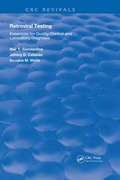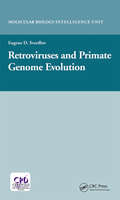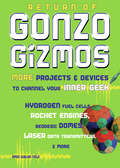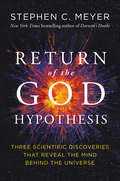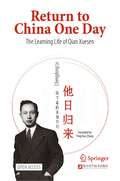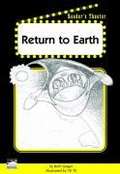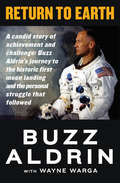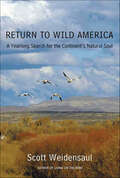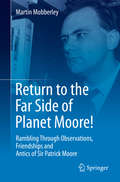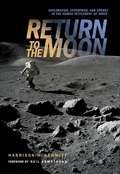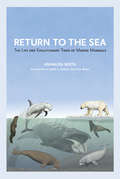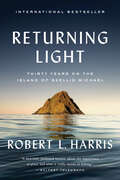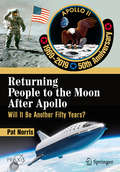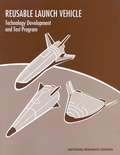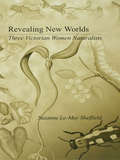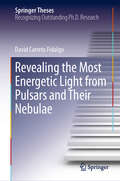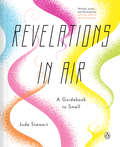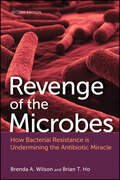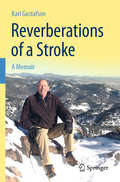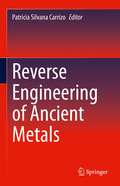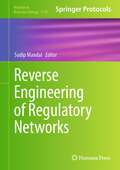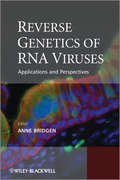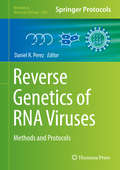- Table View
- List View
Retroviral Testing: Essentials For Quality Control and Laboratory Diagnosis (Routledge Revivals)
by Niel T. Constantine Johnny D. Callahan Douglas M. WattsFirst published in 1992, Retroviral Testing: Essentials for Quality Control and Laboratory Diagnosis is a concise, well-organized volume that discusses the background of retroviral disease, available testing technologies, test result interpretation, new testing alternatives, and essential quality control/quality assurance measures necessary for achieving accurate test results. It provides fundamental information on the epidemiology and infections caused by HIV and HTLV retroviruses, in addition to covering standards for handling blood samples.Other features include a description of immune responses to retroviral agents and a detailed examination of the principles, interpretation, usage and advantages of numerous screening and confirmatory assays. Methods to evaluate diagnostic assays and statistical methods to assess test performance are covered. The text is supplemented by 57 diagrams and 14 tables, including an extensive list of over 130 diagnostic assays for the retroviruses.Retroviral Testing: Essentials for Quality Control and Laboratory Diagnosis is an absolutely critical reference for all medical laboratories, medical technologists, educators, blood bank and immunology supervisors and personnel, and organizations such as WHO and CDC.
Retroviruses and Primate Genome Evolution
by Eugene D. SverdlovThis book describes the role of the obligate inhabitants of all vertebrate genomes—endogenous retroviruses, especially those emerged in genomes rather recently, during primate evolution. It specially focuses on human endogenous retroviruses as well as other retroelements.
Return of Gonzo Gizmos: More Projects & Devices to Channel Your Inner Geek
by Simon Quellen FieldThis fresh collection of more than 20 science projects--from hydrogen fuel cells to computer-controlled radio transmitters--is perfect for the tireless tinkerer. Innovative activities include taking detailed plant cell photographs through a microscope using a disposable camera; building a rocket engine out of aluminum foil, paper clips, and kitchen matches; and constructing a geodesic dome out of gumdrops and barbecue skewers. Organized by scientific topic, each chapter includes explanations of the physics, chemistry, biology, or mathematics behind the projects. Most of the devices can be built using common household products or components available at hardware or electronic stores, and each experiment contains illustrated step-by-step instructions with photographs and diagrams that make construction easy. No workbench warrior, science teacher, or grown-up geek should be without this idea-filled resource.
Return of the God Hypothesis: Three Scientific Discoveries That Reveal the Mind Behind the Universe
by Stephen C. MeyerThe New York Times bestselling author of Darwin’s Doubt presents groundbreaking scientific evidence of the existence of God, based on breakthroughs in physics, cosmology, and biology. Beginning in the late 19th century, many intellectuals began to insist that scientific knowledge conflicts with traditional theistic belief—that science and belief in God are “at war.” Philosopher of science Stephen Meyer challenges this view by examining three scientific discoveries with decidedly theistic implications. Building on the case for the intelligent design of life that he developed in Signature in the Cell and Darwin’s Doubt, Meyer demonstrates how discoveries in cosmology and physics coupled with those in biology help to establish the identity of the designing intelligence behind life and the universe. Meyer argues that theism — with its affirmation of a transcendent, intelligent and active creator — best explains the evidence we have concerning biological and cosmological origins. Previously Meyer refrained from attempting to answer questions about “who” might have designed life. Now he provides an evidence-based answer to perhaps the ultimate mystery of the universe. In so doing, he reveals a stunning conclusion: the data support not just the existence of an intelligent designer of some kind—but the existence of a personal God.
Return to China One Day: The Learning Life of Qian Xuesen
by Chengdong LvThis open access book is intended for common readers who are interested in the life story of Qian Xuesen (also know as Tsien Hsue-Shen). Based on a large number of original archives and historical materials, this book focuses on Qian Xuesen’s years of seeking knowledge from his birth in 1911 to his return to China in 1955 and describes how he grows into a world-known scientist from the aspect of humanity. This book can be used as reference material for Qian Xuesen’s earlier years.
Return to Earth
by Anne Flounders Jessica Wolk-Stanley Beth GeigerPerform this script about renewable resources and green energy.
Return to Earth
by Buzz Aldrin Wayne WargaBuzz Aldrin's courageous, inspiring account of fame and depression following Apollo 11 When Buzz Aldrin returned victorious from the Apollo 11 mission as one of the first men to have walked on the moon, he didn't realize that, in other ways, his odyssey had just begun. "There was a jolt as the small drogue chutes opened," Aldrin relates in the opening passages of Return to Earth, remembering his abrupt descent into the gravity of the blue planet. "We landed with all the grace of a freight elevator." And with that atmospheric splash, Aldrin and coauthor Wayne Warga take us on a journey through the human side of the space program as the astronaut learns to cope with the sudden pressures of being a lionized public persona. In honest, stripped-away prose, Aldrin reveals a side of instant fame for which neither West Point nor NASA could have ever prepared him. One minute a fighter pilot and engineer, the next a cultural icon burdened with the adoration of thousands, Aldrin gives a candid account of the depression that resulted from trying to be too many things to too many people, leading the astronaut to later remark, "I traveled to the moon, but the most significant voyage of my life began when I returned from where no man had been before." Speaking openly about the affair that threatened his marriage and the concerns that plagued him upon returning from the historic mission, Aldrin pens a compelling memoir that also serves as an excellent guide for those times in life when power and success conspire to corrupt even the best of us.
Return to Wild America: A Yearlong Search for the Continent's Natural Soul
by Scott WeidensaulIn 1953, birding guru Roger Tory Peterson and noted British naturalist James Fisher set out on what became a legendary journey-a one hundred day trek over 30,000 miles around North America. They traveled from Newfoundland to Florida, deep into the heart of Mexico, through the Southwest, the Pacific Northwest, and into Alaska's Pribilof Islands. Two years later, Wild America, their classic account of the trip, was published. On the eve of that book's fiftieth anniversary, naturalist Scott Weidensaul retraces Peterson and Fisher's steps to tell the story of wild America today. How has the continent's natural landscape changed over the past fifty years? How have the wildlife, the rivers, and the rugged, untouched terrain fared? The journey takes Weidensaul to the coastal communities of Newfoundland, where he examines the devastating impact of the Atlantic cod fishery's collapse on the ecosystem; to Florida, where he charts the virtual extinction of the great wading bird colonies that Peterson and Fisher once documented; to the Mexican tropics of Xilitla, which have become a growing center of ecotourism since Fisher and Peterson's exposition. And perhaps most surprising of all, Weidensaul finds that much of what Peterson and Fisher discovered remains untouched by the industrial developments of the last fifty years. Poised to become a classic in its own right, Return to Wild America is a sweeping survey of the natural soul of North America today.
Return to the Far Side of Planet Moore!
by Martin MobberleyThe result of an exhaustive study of Sir Patrick Moore's observations of the Moon and planets for more than 60 years, this book is a fantastic companion to the extremely popular, "It Came From Outer Space Wearing an RAF Blazer!" written by the same author. Moore recorded his telescopic observations in his logbooks, which are reproduced and described here in detail, along with his sketches and notes. In this light, the author discusses the factors that caused Moore to switch from lunar observing to planetary and variable star observing. He has also included personal recollections and humorous anecdotes from Moore's friends and acquaintances, as well as a look at his best loved books. Further chapters describe Moore's foreign travels and correspondence with those back home. Lastly, the author has not neglected a few of Moore's most memorable television and radio appearances, which are examined along with a close up of what it was like to visit Moore's beloved home of Farthings in Selsey. Essentially, this is a book written by popular demand from the readers of the author's original biography, who craved more of Moore!
Return to the Moon: Exploration, Enterprise, and Energy in the Human Settlement of Space
by Neil Armstrong Harrison SchmittThe Moon is not just a "local" destination, argues former NASA Astronaut Harrison Schmitt. As a destination, the Moon presents us with a goal that tests our resourcefulness and determination. How much are we willing to spend to re-establish ourselves as space-farers? Return to the Moon proposes that we begin planning, and now, for the establishment of human outposts on the Moon — not just as an exercise in technology and discovery, and not just as a way of fulfilling our destiny as explorers and pioneers. Schmitt, having himself traveled to and literally walked on the Moon, is no stranger to technology, discovery, and a sense of our destiny as explorers; but in this book he focuses on a return to the moon as a business proposition.
Return to the Sea: The Life and Evolutionary Times of Marine Mammals
by Annalisa BertaReturn to the Sea portrays the life and evolutionary times of marine mammals--from giant whales and sea cows that originated 55 million years ago to the deep diving elephant seals and clam-eating walruses of modern times. This fascinating account of the origin of various marine mammal lineages, some extinct, others extant but threatened, is for the non-specialist. Set against a backdrop of geologic time, changing climates, and changing geography, evolution is the unifying principle that helps us to understand the present day diversity of marine mammals and their responses to environmental challenges. Annalisa Berta explains current controversies and explores patterns of change taking place today, such as shifting food webs and predator-prey relationships, habitat degradation, global warming, and the effects of humans on marine mammal communities.
Returning Light: Thirty Years on the Island of Skellig Michael
by Robert L. HarrisThe Acclaimed International Bestseller "Reading Returning Light is a spiritual experience." —Irish ExaminerBy the lighthouse keeper on the remote, otherworldly Irish island of Skellig Michael, a "profound memoir about the importance of place and what it really means to belong" (Belfast Telegraph)“On Skellig Michael, thousands of birds appear and disappear, erecting towers, coming together in wings of movement which build and unravel over the empty sea. Often, no one else is there to stand beside me on the island. The mind wanders; links with the past are easily made; ancient ways of viewing things come alive.”In 1987, Robert Harris happened upon an unusual job posting in the local paper—a new warden service was being set up on the island of Skellig Michael, and the deadline was imminent. Just weeks later he was on his way to set up camp in one of Ireland’s most remote locations, unaware that he would be making that same journey every May for the next 30 years.Here he transports us to the otherworldly island, a place that is teeming with natural life, including curious puffins that like to visit his hut. From the precipice he has observed a coastline that is relatively unchanged for the last thousand years—a beacon of equilibrium in an ever-changing world.But the island can be fierce too. It’s inhabitable for only five months of the year, and solitude can quickly become isolation as bad weather rolls in to create a veil between Skellig Michael and the rest of the world, when the dizzying terrain can become a very real threat to life.A beautiful and evocative work of nature writing, Returning Light is an extraordinary memoir about the profound effect a place can have on us, and how a remote location can bring with it a great sense of belonging.
Returning People to the Moon After Apollo: Will It Be Another Fifty Years? (Springer Praxis Books)
by Pat NorrisJuly 2019 marks 50 years since Neil Armstrong took his famous first steps on the surface of the Moon. As people around the world celebrate the anniversary of this great American achievement, they might wonder why there have been no further human missions to the Moon since Apollo 17 in 1972. This book assesses the legacy of the Apollo missions based on several decades of space developments since the program’s end. The question of why we haven’t sent humans back to the Moon is explored through a multidisciplinary lens that weaves together technological and historical perspectives. The nine manned Apollo missions, including the six that landed on the Moon, are described here by an author who has 50 years of experience in the space industry and whose work spanned the Apollo 8–13 missions. The final section of the book provides a comprehensive assessment of today’s programs and current plans for sending humans to the Moon.
Reusable Booster System: Review and Assessment
by Assessment Committee for the Reusable Booster System: ReviewOn June 15, 2011, the Air Force Space Command established a new vision, mission, and set of goals to ensure continued U. S. dominance in space and cyberspace mission areas. Subsequently, and in coordination with the Air Force Research Laboratory, the Space and Missile Systems Center, and the 14th and 24th Air Forces, the Air Force Space Command identified four long-term science and technology (S&T) challenges critical to meeting these goals. One of these challenges is to provide full-spectrum launch capability at dramatically lower cost, and a reusable booster system (RBS) has been proposed as an approach to meet this challenge. The Air Force Space Command asked the Aeronautics and Space Engineering Board of the National Research Council to conduct an independent review and assessment of the RBS concept prior to considering a continuation of RBS-related activities within the Air Force Research Laboratory portfolio and before initiating a more extensive RBS development program. The committee for the Reusable Booster System: Review and Assessment was formed in response to that request and charged with reviewing and assessing the criteria and assumptions used in the current RBS plans, the cost model methodologies used to fame [frame?] the RBS business case, and the technical maturity and development plans of key elements critical to RBS implementation. The committee consisted of experts not connected with current RBS activities who have significant expertise in launch vehicle design and operation, research and technology development and implementation, space system operations, and cost analysis. The committee solicited and received input on the Air Force launch requirements, the baseline RBS concept, cost models and assessment, and technology readiness. The committee also received input from industry associated with RBS concept, industry independent of the RBS concept, and propulsion system providers which is summarized in Reusable Booster System: Review and Assessment.
Reusable Launch Vehicle: Technology Development and Test Program
by Committee on Reusable Launch Vehicle Technology Test ProgramThe key to opening the use of space to private enterprise and to broader public uses lies in reducing the cost of the transportation to space. More routine, affordable access to space will entail aircraft-like quick turnaround and reliable operations. Currently, the space Shuttle is the only reusable launch vehicle, and even parts of it are expendable while other parts require frequent and extensive refurbishment. NASA's highest priority new activity, the Reusable Launch Vehicle program, is directed toward developing technologies to enable a new generation of space launchers, perhaps but not necessarily with single stage to orbit capability. This book assesses whether the technology development, test and analysis programs in propulsion and materials-related technologies are properly constituted to provide the information required to support a December 1996 decision to build the X-33, a technology demonstrator vehicle; and suggest, as appropriate, necessary changes in these programs to ensure that they will support vehicle feasibility goals.
Revealing New Worlds: Three Victorian Women Naturalists
by Suzanne Le-May SheffieldThe story of nineteenth-century science often tells a tale of a masculinized professionalizing domain. Scientific man increasingly pushed women out, marginalized them and constructed them as naturally feminine creatures incapable of intellectual work, particularly scientific work. Yet many women participated in various scientific endeavours throughout the century. This work asks why, when the waters were so inviting, did women dive deeply into the swirling maelstrom of scientific practice, scientific controversies and scientific writing? Victorian women certainly recognised that male naturalists were not always willing to welcome them warmly into their inner sanctum of scientific work honour and prestige. Moreover, they recognised the existence of a more general social stigma that thwarted any woman's participation in intellectual endeavours. However, their fascination with algology, botany and entomology led Margaret Gatty, Marianne North and Eleanor Ormerod to reach beyond acceptable gendered roles, to undertake field work, to paint, write, popularize, experiment and discover. Each exhibited a passion for their chosen field, a need for intellectual, artistic and scientific work, and a desire for scientific recognition and renown. This book examines the ability of women to understand themselves and respond to their needs as complex human beings. Within a framework of socially and scientifically constructed norms, these Victorial women use d science as a path to self-awareness and intellectual accomplishment.
Revealing the Heart of the Galaxy
by Robert H. SandersWritten in an informal and engaging style, this volume traces the discoveries that led to our understanding of the size and structure of the Milky Way, and the conclusive evidence for a massive black hole at its center. Robert H. Sanders, an astronomer who witnessed many of these developments, describes how we parted the veil of interstellar dust to probe the strange phenomena within. We now know that the most luminous objects in the Universe - quasars and radio galaxies - are powered by massive black holes at their hearts. But how did black holes emerge from being a mathematical peculiarity, a theoretical consequence of Einstein's theory of gravity, to become part of the modern paradigm that explains active galactic nuclei and galaxy evolution in normal galaxies such as the Milky Way? This story, aimed at non-specialist readers and students and historians of astronomy, will both inform and entertain.
Revealing the Most Energetic Light from Pulsars and Their Nebulae (Springer Theses)
by David Carreto FidalgoThis book reports on the extraordinary observation of TeV gamma rays from the Crab Pulsar, the most energetic light ever detected from this type of object. It presents detailed information on the painstaking analysis of the unprecedentedly large dataset from the MAGIC telescopes, and comprehensively discusses the implications of pulsed TeV gamma rays for state-of-the-art pulsar emission models. Using these results, the book subsequently explores new testing methodologies for Lorentz Invariance Violation, in terms of a wavelength-dependent speed of light. The book also covers an updated search for Very-High-Energy (VHE), >100 GeV, emissions from millisecond pulsars using the Large Area Telescope on board the Fermi satellite, as well as a study on the promising Pulsar Wind Nebula candidate PSR J0631. The observation of VHE gamma rays is essential to studying the non-thermal sources of radiation in our Universe. Rotating neutron stars, also known as pulsars, are an extreme source class known to emit VHE gamma rays. However, to date only two pulsars have been detected with emissions above 100 GeV, and our understanding of their emission mechanism is still lacking.
Revelations in Air: A Guidebook to Smell
by Jude StewartAn extraordinary, strange, and startlingly beautiful exploration of smell, the least understood of our five senses The nose on your face is the Buckingham Palace Guard of your body, the matre d' of all taste, as well as the seducer of your imagination, and memory—and Jude Stewart has charmed them all into a wicked, poetic and illuminating tour of their mysterious domains. —Jack Hitt, author of Bunch of Amateurs Overlapping with taste yet larger in scope, smell is the sense that comes closest to pure perception. Smell can collapse space and time, unlocking memories and transporting us to worlds both new and familiar. Yet as clearly as each of us can recognize different smells--the bright tang of citrus, freshly sharpened pencils, parched earth after rain--few of us understand how and why we smell. In Revelations in Air, Jude Stewart takes us on a fascinating journey into the weird and wonderful world of smell. Beginning with lessons on the incredible biology and history of how our noses work, Stewart teaches us how to use our noses like experts. Once we're properly equipped and ready to sniff, Stewart explores a range of smells—from lavender, cut grass and hot chocolate to cannabis and old books—using smell as a lens into art, history, science, and more. With an engaging colorful design and exercises for readers to refine their own skills, Revelations in Air goes beyond science or history or chemistry--it's a doorway into the surprising, pleasurable, and unfamiliar landscape of smell.
Revenge of the Microbes: How Bacterial Resistance is Undermining the Antibiotic Miracle (ASM Books)
by Brenda A. Wilson Brian T. HoRevenge of the Microbes “What is antibiotic resistance, and why should I care?” Two decades after the first edition of Revenge of the Microbes: How Bacterial Resistance Is Undermining the Antibiotic Miracle warned of the looming threat of antibiotic resistance, it is now upon us. Not only has the spread of antibiotic resistance continued unabated, but the emergence of multidrug-resistant “superbugs” is poised to set medical progress back centuries. Several distinct biological, social, economic, and technological factors have resulted in us only barely keeping pace with these new threats. In this edition of Revenge of the Microbes, the authors detail the intricacies of the antibiotic-microbe arms race. Beginning with a historical perspective on antibiotics and their profound impact on both modern medicine and present-day society, they review our current arsenal against infectious diseases and the various ways pathogens evade or overcome them. The authors examine the practices and policies driving the discovery and development of new antibiotics, what happens to antibiotics once they are released into the environment, how antibiotic-resistant bacteria evolve and spread, and the urgency for finding alternative approaches to combating infections. This discussion of the controversies surrounding antibiotics will empower readers—citizen scientists, policy makers, pharmaceutical researchers, and medical professionals alike—to generate informed opinions on antibiotic usage and stewardship as we contend with fewer effective antibiotics. Reader-friendly and comprehensible, this new edition of Revenge of the Microbes engages a diverse audience of scientists, clinicians, educators, students, lawyers, environmentalists, and public health advocates as it explores the ever-changing landscape of the antibiotic resistance crisis. For anyone interested in antimicrobial resistance (AMR), this is a completely approachable 360-degree view of a very complex topic. The authors don’t dilute the science but manage to deliver it in language and examples that everyone can digest. Don’t miss the “Points to Ponder” at the end of each chapter. These thought-provoking nuggets will inspire creative thinking even in the most experienced AMR authorities. — JEAN B. PATEL, PhD, D(ABMM), Principle Scientist, Scientific Affairs, Microbiology, Beckman Coulter; former Science Team Lead, Antibiotic Resistance Coordination and Strategy Unit, CDC
Reverberations of a Stroke: A Memoir
by Karl GustafsonIn the early morning hours of Feb. 1, 2016, Karl Gustafson became instinctively aware that something catastrophic was happening inside him. A severe headache that had persisted for days had taken a sudden turn for the worse, and a clear inner voice ordered him to obtain immediate help. With determined effort, he tapped out the digits “9-1-1” on his phone—bringing an ambulance to his door quickly and saving his life. Emergency Room doctors would soon learn that Professor Gustafson, a renowned American mathematician, had suffered a deep brain hemorrhage, and that the situation was dire. By the time his condition was diagnosed, blood had pooled into all four ventricles of Gustafson’s brain and he was comatose. Against all odds and surprising everyone, the author emerged from a near-death state to go on to what he calls his “Second Life”. This is the story of his miraculous journey of recovery, an inspirational tale of grit and determination, in his own words.
Reverse Engineering of Ancient Metals
by Patricia Silvana CarrizoThis book examines archaeometallurgy and the preservation of ancient materials for cultural heritage. Through understanding the internal structures of relevant ancient materials, their chemical composition, resistance, hardness, etc., their conservation can be more effectively addressed. Preserving cultural artifacts, such as those from border sites, funerary contexts (burials), railway lines, ceremonial sites and road infrastructure, is necessary to provide perspective to a culture’s trajectory. This book addresses how Reverse Engineering can disseminate knowledge of a culture’s heritage by offering technology that can help restore artifacts so they may be displayed and utilized as educational objects.
Reverse Engineering of Regulatory Networks (Methods in Molecular Biology #2719)
by Sudip MandalThis volume details the development of updated dry lab and wet lab based methods for the reconstruction of Gene regulatory networks (GRN). Chapters guide readers through culprit genes, in-silico drug discovery techniques, genome-wide ChIP-X data, high-Throughput Transcriptomic Data Exome Sequencing, Next-Generation Sequencing, Fuorescence Spectroscopy, data analysis in Bioinformatics, Computational Biology, and S-system based modeling of GRN. Written in the highly successful Methods in Molecular Biology series format, chapters include introductions to their respective topics, lists of the necessary materials and reagents, step-by-step, readily reproducible laboratory protocols, and key tips on troubleshooting and avoiding known pitfalls. Authoritative and cutting-edge, Reverse Engineering of Regulatory Networks aims to be a useful and practical guide to new researchers and experts looking to expand their knowledge.
Reverse Genetics of RNA Viruses
by Anne BridgenReverse genetics, the genetic manipulation of RNA viruses to create a wild-type or modified virus, has led to important advances in our understanding of viral gene function and interaction with host cells. Since many severe viral human and animal pathogens are RNA viruses, including those responsible for polio, measles, rotaviral diarrhoea and influenza infections, it is also an extremely powerful technique with important potential application for the prevention and control of a range of human and animal viral diseases.Reverse Genetics of RNA Viruses provides a comprehensive account of the very latest developments in reverse genetics of RNA viruses through a wide range of applications within each of the core virus groups including; positive sense, negative sense and double stranded RNA viruses. Written by a team of international experts in the field, it provides a unique insight into how the field has developed, what problems are being addressed now and where applications may lead in the future. It will prove invaluable to bioscience, medical and veterinary students, those starting research in this area as well as other researchers and teachers needing to update their knowledge of this fast-moving field.An authoritative, comprehensive overview of reverse genetics in RNA Viruses.Includes numerous examples of cutting- edge applications of reverse genetics within each of the RNA viral groups. Written by a team of international experts, including some of the leading researchers in the field.
Reverse Genetics of RNA Viruses
by Daniel R. PerezThis volume is a compilation of sixteen chapters that detail reverse genetics protocols. Reverse Genetics of RNA Viruses: Methods and Protocols guides readers through comprehensive protocols on RNA viruses, that were the most challenging to obtain and/or that were developed most recently. Written in the highly successful Methods in Molecular Biology series format, chapters include introductions to their respective topics, lists of the necessary materials and reagents, step-by-step, readily reproducible laboratory protocols, and tips on troubleshooting and avoiding known pitfalls. Authoritative and practical, Reverse Genetics of RNA Viruses: Methods and Protocols aims to ensure successful results in the further study of this vital field.
